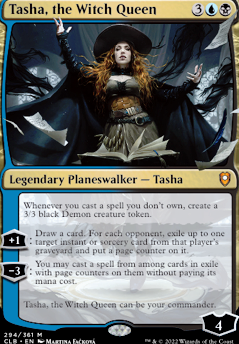The following ten parameters have been used to determine the strength of the deck. For each, a score of 5 (very good), 4 (good), 3 (mediocre), 2 (bad) or 1 (very bad) has been allocated; when totalized this score represents the power rating of the deck (maximum score is 50 points).
- Mana: indicates the availability of mana sources within the deck.
- Ramp: indicates the speed at which mana sources within the deck can be made available.
- Card Advantage: indicates availability of filter- and draw resources represented within the deck.
- Overall speed: indicates the deck’s potential for pace, based on resource availability and mana curve.
- Combo: indicates the measure of combo-orientation of the deck.
- Army: indicates the deck’s creature-army strength.
- Commander: indicates how much the deck is commander-oriented/dependent (less dependency is better).
- Interaction: indicates how much this deck can mess with opponents’ board states and turn-phases.
- Resilience: indicates whether the deck can prevent and take punches.
- Spellpower: indicates the availability and strength of high-impact spells.
Mana: 4
This Tasha deck aims to have enough resources available on a turn-by-turn basis, that allows its wielder to cast both his/her own spells AND those of his/her opponents. Therefore, the amount of mana-resources in this deck is relatively high. In all, it contains eleven mana-rocks (of which half only generates colorless mana), a creature that cheapens casts from sources other than the deck wielder’s hand, an instant mana spell and an enchantment that can generate mana based on the amount of perished creatures.
Ramp: 1
Not sure if this would be considered ramping, but an artifact that can steal lands from opposing graveyards has been included. When going for theft, might as well try to go all the way, right?
Card Advantage: 5
In most ways, this deck is all about card-advantage; being able to cast spells from as many graveyards, exile piles, hands and libraries as possible. In terms of direct draw, this deck already has a decent number of options (nine). It also contains a several tutors (two). The way in which this deck’s card-advantage really shines forth, is in its theft options. A whopping thirty cards are geared to this effect (eight of which don’t require additional costs aside from the card’s own CMC), out of which five are specifically focused on stealing non-permanents, seven are focused on stealing permanents and the remaining eighteen can be considered omni-theft cards.
Overall speed: 4
Very decent. About 30% of the deck consists of cheap resourcing and removal. The deck’s average CMC clocks in at 3.34 which is a medium rating. Definitely able to keep pace with the average EDH deck, except maybe decks featuring green or decks very focused on a colorless aspect.
Combo: 1
There’s no focus on combos in this deck.
Army: 4
Overall, this deck’s fighting-force can be considered powerful. Seventy percent of the army’s creatures are not just good combatants, but aid in some way to steal opponents’ stuff. Most of them are hard to block through the application of flight, landwalk-abilities or menace. Very useful as stealing things often requires connecting to the enemy. Stolen creatures join the deck’s own ranks and Tasha generates demon tokens whenever a stolen spell is cast.
Commander: 5
Tasha is fantastic, but she’s definitely not required on the field in order to win games. The deck contains a plethora of other thieving spells/permanents, lots of other card-advantage mechanisms and plenty of creatures to make up for the demons she can bring.
Interaction: 5
Holy-moly, this deck is interaction through and through; mostly with opponents’ hands, libraries and graveyards (the aforementioned thirty theft cards), but it also contains a few decent, cheap-to-cast removal options (eight cards).
Resilience: 3
One cannot expect much direct protection from/for the cards within this deck. However, it does contain a few recursion mechanisms for important stuff. It also features a strong opportunity for life-gain. Most importantly however, the deck is able to use its large number of (non-)permanent theft-cards to recover fast from direct attacks or wipes, by utilizing not just the deck’s own resources but those of others as well.
Spellpower: 5
When it comes to removal, resourcing and theft, half of this deck’s spells are geared to the max. A number of these can even be considered game-ending when cast under the right circumstances.
Total power score: 37
Out of all the EDH decks on this page, this is undoubtedly one of the most fun ones to play. It’s capable of being relatively fast at obtaining resources, it’s extremely versatile in that it can often choose (at least in a general way) what it wants to steal and thereby adapt to lots of different situations and its army can become truly terrifying; especially when Tasha is able to lead things. It only lacks combos, but experience seems to dictate that during most games it doesn’t need these in any way to perform well.

